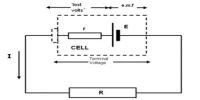We know, if there is a potential difference between the two terminals of a conductor, current flows through it. The quantity of this electric current depends on the potential difference between the two ends of the conductor, the conductor itself and the temperature of it.
George Simon Ohm has discovered the law regarding the relationship between the electric current that flows in a conductor and the potential difference between the two terminals of it- which is known as Ohm’s law.
Example: A current of 4 A is flowing through the filament of the headlight of a motor car. If the potential difference between the two ends of the filament is 12 V, what is the resistance of it?
Here,
Electric current, I = 4 A
Potential difference, V= 12 V
Resistance, R = ?
We know, I = V/R, or, R = V/I
= 12V / 4A = 3 Ω
Answer: 3 Ω












